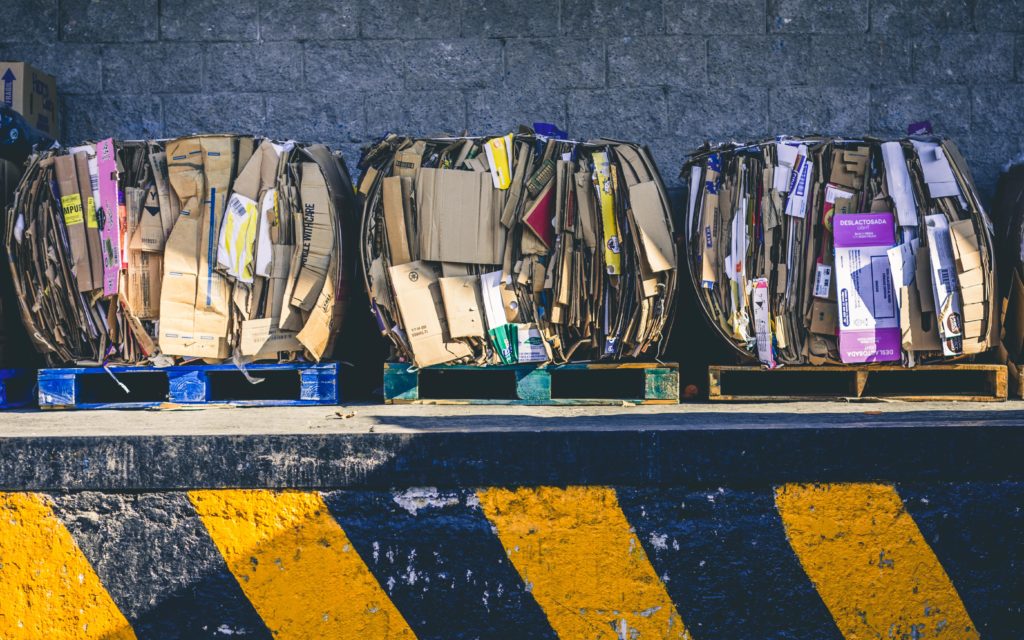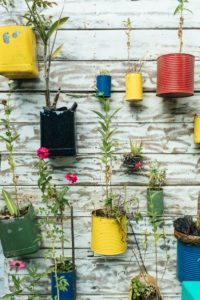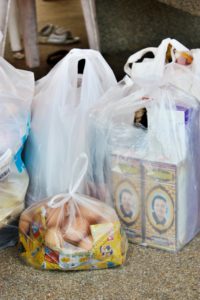What is the solution?
Organisations can eliminate unnecessary packaging, especially single-use plastic, use alternative packaging materials, innovate to reuse and repurpose packaging and invest in local collection and recycling facilities.
Why is tackling packaging important?
Aid organisations rely on packaging for the transport of food and non–food items to beneficiaries – plastic in particular. Plastic packaging is cheap, light and versatile and became a dominant material of our economy. Yet, the negative impact of plastic debris in the environment is widely documented. Plastics are littering beaches, clogging up municipal sewage systems and are found in the deep sea, as well as the most remote mountain areas (1). Due to their small size and low value, plastic packaging is particularly prone to end up in the environment and many countries lack the infrastructure to collect and recycle plastic waste. In addition, greenhouse gas emissions are released through the extraction and refining of fossil fuels, the raw material for plastics, as well as through the energy-intensive process of plastic production and the incineration of plastic waste.

Key solutions
-
#1 Eliminate unnecessary or problematic packaging
Reduce (single-use) packaging to the minimum and eliminate problematic materials. Discover more
-
#2 Adapt the product format
Reduce packaging by adapting the product format.
-
#3 Opt for reusable packaging
Avoid single-use packaging and switch to reusable packaging.
-
#4 Repurpose packaging
Re-design or re-use packaging for a different purpose. Discover more
-
#5 Reduce the impact of packaging raw materials
Switch from fossil-based virgin feedstocks to recycled or renewable materials.
-
#6 Choose recyclable packaging material
Use recyclable or compostable packaging material.
-
#7 Invest in recycling and collection infrastructure
Facilitate and invest in local collection and recycling.
Tools and good practices
-
Joint Initiative, Guidance Note on Regulatory and Legislative Frameworks for Humanitarian Workers
This guidance note provides information on existing frameworks governing plastics and how they are likely to evolve. The note also aims to support awareness-raising efforts and changes in procurement practices. It provides further resources on specific national legislations.
Read here -
Joint Initiative, Webinar Series, Packaging Matters Episode 1: The journey to sustainable packaging: synergies between humanitarian organizations and the private sector
Hear from ALPINTER, Mondi Group and the WFP who shared insights into bottlenecks and levers for humanitarians to make real improvement to packaging. Access webinar recording, presentation and outcome document.
Read here -
Alternatives to Conventional (Petroleum-based) Plastics in Packaging: Definitions, Benefits and Challenges for the Humanitarian Sector , Joint Initiative, 2023 (EN)
The paper aims to provide information and points for reflection, to help both procurement and program staff make more informed decisions on sustainable alternatives to plastics.
Read here -
Ellen MacArthur Foundation, Upstream Innovation. A Guide to Packaging Solutions.
A guide to help organisations innovate towards achieving their circular economy goals for packaging. Whilst the guide is made for the FMCG sector, some of the products are equally used by aid organisations and the provided examples can serve as inspiration.
Read here -
Ellen MacArthur Foundation Learning Hub
A series of learning tools to increase the understanding of plastic pollution, a circular economy for plastic and potential solutions to the problem.
Read here
To go further
-
Joint Initiative, Packaging, Plastics and Climate Change (Infosheet)
An overview of the impact of plastics, and in particular packaging, on climate change.
Read here -
Heinrich Böll Foundation/Break Free From Plastic, Plastic Atlas, 2019
The document provides facts and figures about the growing plastic problem. It also provides arguments as to why a rapid reduction in plastic production and consumption is required.
Read here -
UNEP, From Pollution to Solution. A Global Assessment of Marine Litter and Plastic Pollution, 2021
A publication with key facts and figures on plastic pollution in the oceans.
Read here -
UNEP, Drowning in Plastics. Marine Litter and Plastic Waste Vital Graphics.
A publication with infographics on plastic waste and marine plastic pollution.
Read here
Sources
(1) Adane et.al., 2011, Survey on the usage of plastic bags, their disposal and adverse impacts on environment: A case study in Jimma City, Southwestern Ethiopia, Journal of Toxicology and Environmental Health Sciences Vol. 3(8) pp. 234-248; Chiba et.al., 2018, Human footprint in the abyss: 30 year records of deep-sea plastic debris, Marine Policy, Vol. 96, pp. 204–212; Allen et.al., 2019, Atmospheric transport and deposition of microplastics in a remote mountain catchment, Nature Geoscience, Vol. 12, pp. 339–344.
(2) CITEO, Panorama des emballages ménagers en France, 2022. Read here.
(3) Ellen MacArthur Foundation, The New Plastics Economy: Rethinking the Future of Plastics & Catalysing Action, 2017. Read here.
(4) Geyer, Jambeck, and Law, 2017, Production, use, and fate of all plastics ever made, Sci. Adv., 3 (7), Article 1700782.
(5) Ellen MacArthur Foundation, The New Plastics Economy: Catalysing Action, 2017. Read here.
(6) UNEP, Historic day in the campaign to beat plastic pollution: Nations commit to develop a legally binding agreement, 2022. Read here.
(7) UN Principles for Responsible Investment, The Plastic Landscape: Regulations, Policies and Influencers, 2019. Read here.
(8) Ellen MacArthur Foundation, The European Plastics Pact. Read here.
(9) Environmental Emergencies Centre, Joint Initiative on Sustainable Humanitarian Assistance Packaging Waste Management. Read here.
(10) ICRC Afghanistan Pilot: Replacing Plastic with cardboard in NFI Distributions. Read here
(11) ACTED Lebanon: A holistic approach to reducing and managing waste. Read here
Cover photo © Marcell Viragh/Unsplash.



